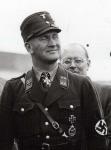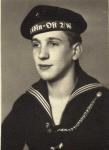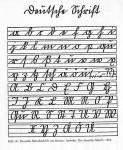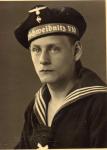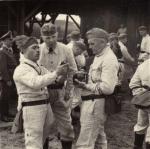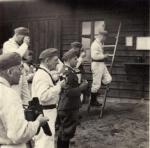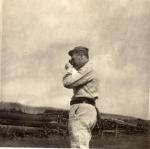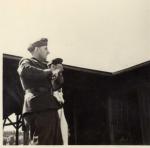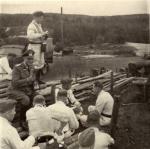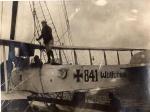-
Posts
2,143 -
Joined
-
Last visited
-
Days Won
10
Content Type
Profiles
Forums
Blogs
Gallery
Events
Store
Everything posted by Odulf
-

Patch on Adolfs uniform
Odulf replied to The Prussian's topic in Germany: Third Reich: Research, Documentation & Photographs
The "patch" of the "Caporale d'Onore della M.V.S.N." (Corporal of Honour) is an Italian fascist decoration and similar to the badge worn by Mussolini. It was presented by the Duce on 25-09-1937 in Munich when Mussolini visited Hitler. -

Cap tally
Odulf replied to Leuchtturm's topic in Great Britain: Militaria: Badges, Uniforms & Equipment
The tally for the Royal Yacht is the odd one out, it has the standard lettering with the crown between the two words. Under Queen Victoria the tally for the RY was plain black silk. Under Edward VII the text ROYAL [crown] YACHT was introduced; the crown was a "King's Crown" and remained until in 1953 Elizabeth II became the new monarch and thus all crowned insignia were altered. Another extra ordinary tally was for H.M.S. OPHIR. She was a Royal Mail Steamer who was temporary employed as Royal Yacht for the Royal Tour of the Duke and Duchess of Cornwall & York in 1901. The ship's company was boosted by transfering men from the official Royal Yachts (H.M.Y Victoria & Albert and Osborne) and all the men dressed as sailors o/b the Ophir wore a tally with the ship's name sided by little flags. -

Cap tally
Odulf replied to Leuchtturm's topic in Great Britain: Militaria: Badges, Uniforms & Equipment
This is hard to say. These fancy letters are not regular for RN ribbons. The name H.M.S. NILE was carried through the 19th Century by three different units. The earliest RN cap tallies (first half of the 19th Century) had the name painted in yellow or gold on the ribbon, all later ribbons were standard Navy issue with the name woven in the silk. But we do see these fancy letters often on cap tallies worn by little boys and girls on their sailor's hat or sennet hat which were fashionable from about the mid 19th century until the Great War. So to my opinion this tally was never worn officially by a RN rating. -

NSDAP Golden Party Badge in wear
Odulf replied to LarryT's topic in Germany: Third Reich: Research, Documentation & Photographs
Quite an early Army uniform, around 1935 I would think, probably a conscripted Party member who joined the club at an early age. -

NSDAP Golden Party Badge in wear
Odulf replied to LarryT's topic in Germany: Third Reich: Research, Documentation & Photographs
Perhaps Jock... On the other hand, the guy looks to be in his 40s.. The picture was taken after Sept. 1939 (hence the KM tally), so he must have been 18 or a bit older in 1918. The lad is about 15 years (born around 1925), so he could be his son, foster son, or relative in another way... It is all open for speculation because there is no information on the back of the picture. It just shows, that the GPB was not only worn on the Party uniform. Perhaps the guy was a Party official, but also a Kriegsmarine reservist, and drummed up for war service. Note also this: http://gmic.co.uk/index.php/gallery/image/7940-nsdap-15-ribbar-army-gefreiter-odulf-gmic/ Another example of a distinguished Party member in a soldier's uniform. -

NSDAP Golden Party Badge in wear
Odulf replied to LarryT's topic in Germany: Third Reich: Research, Documentation & Photographs
-

Badges for review please
Odulf replied to RRicardo's topic in Great Britain: Militaria: Badges, Uniforms & Equipment
I have my doubts about the South Staffords... -

WW II - What's this helmet?
Odulf replied to Hugh's topic in Great Britain: Militaria: Badges, Uniforms & Equipment
Please note also: http://gmic.co.uk/index.php/topic/59647-steel-helmet-dutch/?hl=turtle#entry558919 -
Some more HJ tallies. Interesting to note that the Matrosenobergefreiter (1st photo) is also wearing the Gold Party Badge, another proof that a long running party membership did not include a high rank in the Wehrmacht. In 1938 the tekst on the tallies was changed from Latin letters to "Gothic" script.
-

Uncategorised One word translation
Odulf replied to P.F.'s topic in Germany: Third Reich: Research, Documentation & Photographs
-

Uncategorised One word translation
Odulf replied to P.F.'s topic in Germany: Third Reich: Research, Documentation & Photographs
I support arb, it is Reichsparteitag written in Süterlinschrift -
At this moment there are only few recommendable books written about HJ uniforms - inclusive Marine HJ - these books are: - The Hitler Youth - by David Littlejohn (assisted by Harry Hinds), 1988, Agincourt Publishers - H.J. (Vol. 1 & 2) - by J.R. Angolia, 1991, R.J.Bender - Handbook of the Hitler Jugend - by Wilhelm P.B.R. Saris (etc.), 2009, R.J.Bender All of these mention the cap tallies of the marine Hitler Jugend, and the development of the HJ Naval caps. I would advice students of this matter to get hold of these books to get a better view on the matter.
-
Nice collection, indeed! The "Kronprinz Wilhelm" was a n AMC, in fact a war ship, and the U "Deutschland" was a merchant ship. Under international law, a neutral country cannot allow any military unit of the belligerent porties on its territory for a longer period of time. If so, these units have to be interned for the duration of the war. To allow a belligerent military's unit to repair and leave the territory would lift the neutrality and make the country a belligerent also. However, a merchant ship, like the U "Deutschland", of a belligerent country is not a military's unit. France, England and Germany could there fore trade with the USA. This situation changed when the USA took Side with the allied nations and Germany become an enemy. At that moment all interned units became spoiles of war. When ships from opposite belligerent countries would enter a neutral port (for taking in water or coal), there should be a specific time in departure between their leaving, so that they could get to international waters without being shot at in neutral territory. Ships that have to stay in port for a longer period (e.g. to use dry dock) would have to be interned. During WW1 many Germn ships were interned in neutral countries. Also ship's companies from wrecked ships setting foot on neutral ground should be interned. Note for instance the escape of the late Admiral Canaris from SMS Dresden from Chile, during WW1 and the short stay of SMS Goeben in Messiana (neutral Italy). PS Belligerent = country at war Units = soldiers, sailors, airmen, ships, war planes, etc.
-
Some more photos added to my S.M.S. Wolf picture file. Most interesting is the press photo of the famous reconnaissance seaplane "Wölfchen" (Little Wolf), a Friedrichshafen FF 33E reconnaicance seaplane, whih was the "eyes" of S.M.S. Wolf. She was crewed by Leutnant zur See d.R. Alexander Stein and Oberflugmeister Paul Fabeck. The unidentified Feuerwerksmaat is wearing the ribbon of the EK2, no doubt for actions o/b S.M.S. Wolf.


